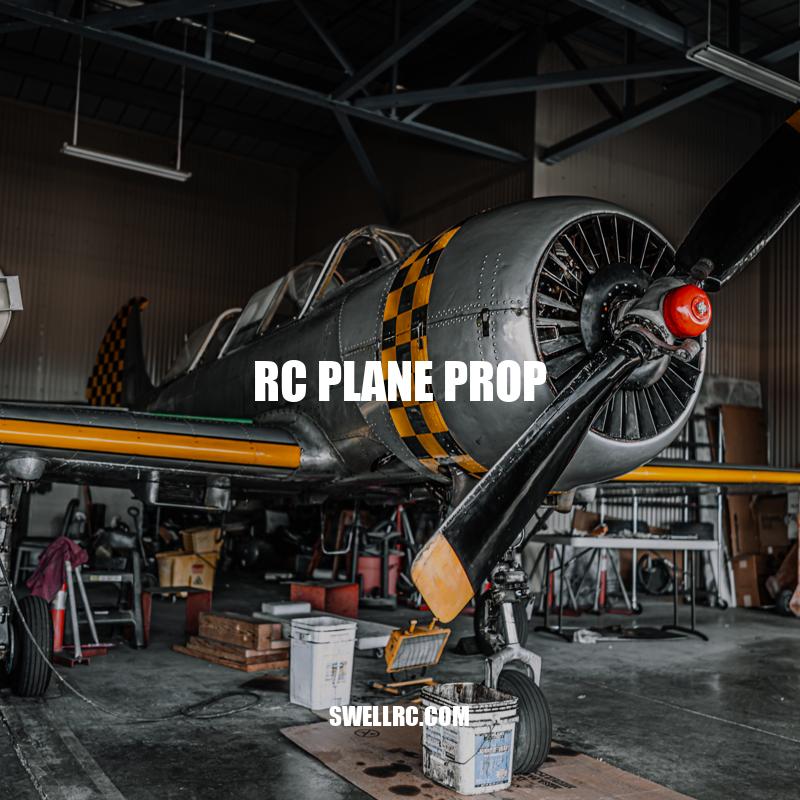Mastering RC Plane Prop Selection and Maintenance
An RC plane prop, short for propeller, is one of the most important components of an RC plane. The prop is responsible for generating thrust and propelling the plane forward. Without a properly functioning prop, an RC plane cannot fly properly or efficiently. There are several types of RC plane props available with varying sizes and pitches, each designed to suit different planes and flight conditions. In this article, we will explore the different types of RC plane props, how to choose the right prop for your plane, maintenance and replacement tips, upgrades and performance enhancements, safety measures, and more.
Types of RC Plane Props
There are several types of RC plane props available on the market today. Each type is designed to suit different planes and flight conditions. Here are a few key characteristics of the various types of props:
- Materials: RC plane props can be made from a range of materials, including plastic, wood, and carbon fiber. Different materials offer different benefits and drawbacks, so it’s important to select the right one for your plane’s specific needs.
- Sizes and pitches: Props come in a range of sizes and pitches, which can greatly impact an RC plane’s performance. A larger prop with a higher pitch can produce more thrust and speed, but it can also require more power to operate.
- Fixed-pitch vs. variable-pitch: Some props have a fixed pitch, which means the angle of the blades cannot be adjusted. Others are variable-pitch, offering greater control over the plane’s speed and ability to climb.
When choosing an RC plane prop, it’s important to consider these factors in order to match the prop to your plane’s specific needs. Some websites like Amazon or RC Planet offer a wide range of options and customer reviews that can help you make an informed decision.
What are the benefits and drawbacks of different materials used for RC plane props?
Benefits and drawbacks of different materials used for RC plane props vary. Wood is durable but heavy. Plastic is lightweight but not as durable. Carbon fiber is strong and lightweight but expensive. Aluminum is also durable but heavy and can be expensive. Each material has its own advantages and disadvantages depending on the specific needs of the RC plane.
Choosing the Right Prop
- Plane weight and power affect prop selection
- Importance of calculating the proper size and pitch for your plane
Choosing the right prop for your RC plane is crucial for its performance. Here are some things to consider when selecting a prop:
– Plane weight and power: The weight and power of your plane affect the type of prop that will work best with it. A lighter plane may need a smaller prop, while a more powerful plane may require a larger prop to generate enough thrust.
– Proper size and pitch: It’s important to calculate the proper size and pitch for your specific plane. This can be done using propeller sizing charts or by consulting with RC plane experts.
Here’s an example table that can help you determine the right propeller size for your plane. This table shows the recommended prop diameter for different engine sizes and types:
| Engine Size | 2-Stroke | 4-Stroke |
|---|---|---|
| .10-.15 | 8×4 – 9×6 | 12×6 – 13×7 |
| .20-.25 | 9×6 – 10×7 | 13×7 – 14×8 |
| .35-.45 | 11×6 – 11×7 | 16×6 – 16×8 |
Once you know what size and pitch of prop is best for your plane, you can easily find a range of options online at places like Tower Hobbies or HobbyKing.
How do you calculate the proper size and pitch for an RC plane prop?
The proper size and pitch of an RC plane prop can be calculated by considering factors such as the motor’s power output and the plane’s weight and intended use. There are some online prop calculators and formulas available to assist in the calculation.
Regular maintenance of your RC plane’s prop is important to ensure optimal performance and prevent damage to the plane. Here are some things to keep in mind when it comes to maintenance and replacement of your RC plane’s prop:
– Proper cleaning and lubrication: It’s important to keep your prop clean and lubricated to prevent damage from dirt and debris. Once you’ve removed the prop from the plane, clean it carefully with a soft brush or cloth and lubricate it with prop oil or another appropriate lubricant.
– Signs that indicate that it’s time to replace the prop: Bumps, chips, cracks, or other damage can indicate that it’s time to replace your prop. Worn or damaged prop blades can affect your plane’s performance and even cause it to crash.
If you need to replace your prop, you can find a range of options online at places like Amazon or Horizon Hobby. Remember to select the appropriate size and pitch for your plane.
What are some signs that indicate it’s time to replace your RC plane’s prop?
Some signs that indicate it’s time to replace your RC plane’s prop include visible damage such as cracks or chips, decreased performance or vibration during flight, or excessive noise coming from the propeller.
Upgrades and Performance Enhancements
- Upgrading your prop can greatly impact your RC plane’s performance
- Options for upgrading to a more efficient or higher-quality prop
- Potential benefits of using a propeller with a different number of blades
If you’re looking to improve your RC plane’s performance, upgrading your prop can be a great option. Here are some things to keep in mind when upgrading your prop:
– Upgrading your prop can greatly impact your RC plane’s performance: Higher-quality, more efficient props can provide better performance in terms of speed, lift, and maneuverability.
– Options for upgrading to a more efficient or higher-quality prop: There are a range of options available online, including props made from materials like carbon fiber or reinforced nylon. Some popular brands include XOAR, Master Airscrew, and APC Propellers.
– Potential benefits of using a propeller with a different number of blades: While most RC planes use two-blade props, using a prop with more or fewer blades can have an impact on your plane’s performance. For example, props with more blades can provide more lift, while props with fewer blades can be more efficient.
Before upgrading your prop, be sure to do your research and select the best option for your specific plane and flying needs. Online forums like RCGroups or RC Universe can also provide helpful insights from fellow RC enthusiasts.
What are the potential benefits of using a propeller with a different number of blades on an RC plane?
Using a propeller with a different number of blades on an RC plane can potentially affect factors such as speed, thrust, and battery life. A propeller with fewer blades may increase speed but reduce thrust, while a propeller with more blades may increase thrust but reduce speed and require more energy from the battery.
When it comes to RC plane props, safety should always be a top priority. Here are some important safety measures to keep in mind:
– Safety measures that should be taken when handling an RC plane prop: Always wear protective gloves and eye gear when handling a prop, and avoid touching the sharp edges of the blades. Keep long hair and loose clothing away from the prop while it’s in motion.
– Props can be dangerous and cause injury if not treated with caution: The high speeds at which the prop rotates can cause serious injury, including cuts, bruises, and even broken bones.
– How to properly handle, install, and remove a prop safely: Make sure your plane’s power source is completely turned off before handling the prop. Install the prop according to the manufacturer’s instructions and make sure it’s securely attached before powering on the plane. To remove the prop, use a prop removal tool or wrap a cloth around the prop hub to avoid cutting your fingers.
Some additional safety tips to keep in mind include making sure your plane is always pointed away from you and others, and never flying your plane in crowded areas or near people or animals. By following proper safety guidelines, you can help ensure a safe and enjoyable experience when flying your RC plane.
What are some additional safety tips to keep in mind when flying an RC plane?
Some additional safety tips to keep in mind when flying an RC plane include always following regulations and guidelines, maintaining a safe distance from people and property, being aware of weather conditions and hazards, and having a spotter to assist in keeping the aircraft in sight.
Conclusion
In conclusion, the RC plane prop is a vital component of any RC plane’s performance. With the options available to choose from, it’s important to research and select the right type and size of prop to maximize your plane’s performance. Regular maintenance and proper handling are crucial in ensuring a safe and enjoyable experience with your RC plane. Upgrading to a more efficient or higher-quality prop can also greatly impact the plane’s overall performance.
If you’re looking to purchase RC plane props, there are many options available online, including hobby shops and specialized RC plane stores. When shopping for props, be sure to keep in mind the weight and power of your plane, and consult with other enthusiasts or forums for recommendations on the best props for your specific model.
Overall, the RC plane prop is a fascinating and complex component that greatly impacts the performance of an RC plane. With proper maintenance, upgrades, and safety measures in place, you can experience the thrill of flying your RC plane with confidence and ease.



